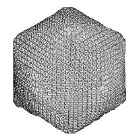Plant Pathology, Department of

James Van Etten Publications
Document Type
Article
Date of this Version
2013
Citation
Plant Physiology, July 2013, Vol. 162, pp. 1215–1224, www.plantphysiol.org.
Abstract
Cells communicate among themselves by electrical activity. Sophisticated membrane-embedded proteins, called ion channels, catalyze rapid, selective, and regulated ion fluxes across membranes (Hille, 2001). The resulting membrane currents are responsible for neuronal activity and the systemic propagation of electrical signals in animals. The activity of some channels is important for muscle movement in animals or growth in plants; other channels sense the concentration of physiological signals and modulate key processes in all kinds of eukaryotic cells. Among the many diverse ion channels in higher organisms, K+ channels are among the most important. One feature of K+ channels is that they conduct K+ ions much better than slightly smaller Na+ ions (Hille, 2001). The selective transport of K+ is involved in many physiological functions, including homeostasis of the membrane potential and the repolarization of the action potential in excitable cells. Because of a universal requirement for selective K+ fluxes across membranes, K+ channels are present in plasma membranes of all cell types in animals and plants. K+ channels also exist in organellar membranes, including mitochondria, chloroplasts, and endoplasmic reticula.


Comments
Copyright 2013 American Society of Plant Biologists. All Rights Reserved. Used by permission.